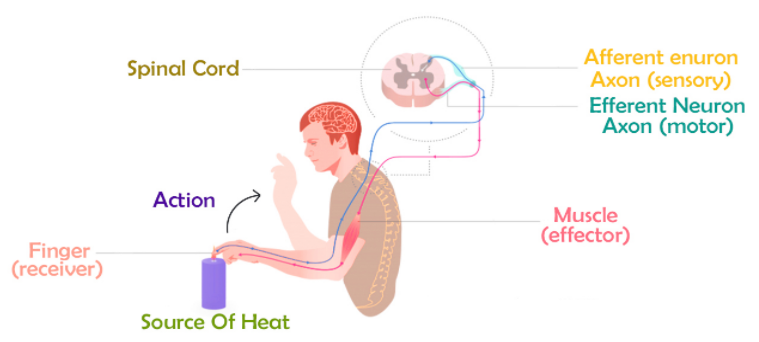
A simple reflex is
A. Climbing up a stair in dark without stumbling
B. The closing of eyes when strong light is flashed over them
C. Tying shoelaces while talking to some person
D. Watering of mouth at sight of favourite food
Answer
507.3k+ views
Hint: Simple reflex action is a spontaneous, speedy action which is produced as a response to any threatening stimuli. Here, impulses travel a path which is quite different from that of conventional stimulus-response processes.
Complete Answer
Reflex action is an automatic response that involves formation of a reflex arc. Reflex arc is a pathway followed by receptor and motor neurons while responding to any stimulus, as per the guidance given by the spinal cord. Following is a detailed discussion of each action mentioned above.
Climbing up a stair in dark without stumbling can be considered as an example of good practiced activity of the brain. Stable movement in darkness is possible due to combined efforts made by the spinal cord and earlier experiences of the brain. Therefore, no reflex arc is formed. So, option A is an incorrect option.
The closing of eyes when strong light is flashed over them can be considered as a simple reflex action. Eyes being quite sensitive to light allow its limited entry only. Therefore, in case of flash, the immediate need of the moment is the closure of eyes to avoid any damage. Therefore, a reflex arc is formed by the spinal cord to do so. Thus, option B is the correct option.
Similarly actions like tying shoelaces while talking to some person or watering of mouth at sight of favourite food are results of good memory and earlier experiences that do not involve formation of any reflex arc. Therefore, option C and D are also incorrect options.
Thus, we can say that option B is the correct answer.

Note:
Formation of the Reflex arc excludes suggestions from the brain in order to speed up the reaction. Such a path is followed by neurons in case of threatening or dangerous situations only. Therefore, it is called an involuntary action as it is not under our control.
Complete Answer
Reflex action is an automatic response that involves formation of a reflex arc. Reflex arc is a pathway followed by receptor and motor neurons while responding to any stimulus, as per the guidance given by the spinal cord. Following is a detailed discussion of each action mentioned above.
Climbing up a stair in dark without stumbling can be considered as an example of good practiced activity of the brain. Stable movement in darkness is possible due to combined efforts made by the spinal cord and earlier experiences of the brain. Therefore, no reflex arc is formed. So, option A is an incorrect option.
The closing of eyes when strong light is flashed over them can be considered as a simple reflex action. Eyes being quite sensitive to light allow its limited entry only. Therefore, in case of flash, the immediate need of the moment is the closure of eyes to avoid any damage. Therefore, a reflex arc is formed by the spinal cord to do so. Thus, option B is the correct option.
Similarly actions like tying shoelaces while talking to some person or watering of mouth at sight of favourite food are results of good memory and earlier experiences that do not involve formation of any reflex arc. Therefore, option C and D are also incorrect options.
Thus, we can say that option B is the correct answer.

Note:
Formation of the Reflex arc excludes suggestions from the brain in order to speed up the reaction. Such a path is followed by neurons in case of threatening or dangerous situations only. Therefore, it is called an involuntary action as it is not under our control.
Recently Updated Pages
What happens to glucose which enters nephron along class 10 biology CBSE

Write a dialogue with at least ten utterances between class 10 english CBSE

A circle is inscribed in an equilateral triangle and class 10 maths CBSE

When the JanmiKudian Act was passed that granted the class 10 social science CBSE

A sector containing an angle of 120 circ is cut off class 10 maths CBSE

The sum of digits of a two digit number is 13 If t-class-10-maths-ICSE

Trending doubts
The shortest day of the year in India

Why is there a time difference of about 5 hours between class 10 social science CBSE

Write a letter to the principal requesting him to grant class 10 english CBSE

What is the median of the first 10 natural numbers class 10 maths CBSE

The Equation xxx + 2 is Satisfied when x is Equal to Class 10 Maths

What is the missing number in the sequence 259142027 class 10 maths CBSE




